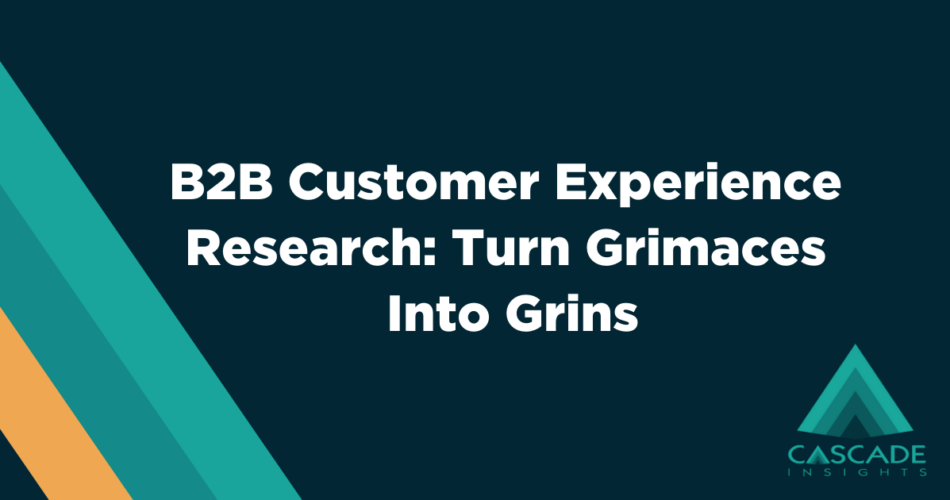Consider the last SaaS app that was implemented at your company. How was the onboarding experience? The day-to-day usage? How well did it integrate with other technologies? Unfortunately, if it’s anything like so many SaaS apps, the software may have been clunky, hard to operate, required a lot of training, onboarding, and well … tested patience.
Now consider the technology that you help to build and market for your company every day. Is it possible that your customers experience any of those same difficulties with your cloud service offering?
B2B Customer Experience Research can help to answer that by providing an understanding of customer satisfaction throughout the customer journey. From initial contact through adoption, renewal, and upgrades, it can show what the customer experience is like throughout the complete lifecycle.
To glean those insights, however, many companies only look to the quantitative telemetry that’s generated by their service. They believe that data alone is enough to draw informed conclusions about their customer experience. We think this is a mistake. Although these metrics are crucial to understanding how customers are using your product and its features, they can’t answer the why behind the numbers.
Including qualitative research lets us get at why people don’t like a piece of software, the onboarding experience, day-to-day usage, and more. More importantly, it can help to turn your customers’ grimaces into grins.
Set the Foundation With Quant
Traditionally, market researchers have utilized quantitative methodologies to examine customer satisfaction. Net Promoter Score (NPS), Customer Effort Score (CES), and Customer Satisfaction Scores (CSAT) are all common frameworks for quantifying customer satisfaction.
These quantitative metrics can help to answer many valuable baseline questions for B2B companies, like:
- Would customers be willing to buy your product or service again?
- What leads customers to recommend you to their peers?
- How satisfied are customers doing business with you?
- What features, capabilities, or interactions delight customers?
- What configurations or integrations tend to lead to happy customers?
When done well, establishing a B2B customer experience program can yield big business benefits. In fact, 75% of customer experience leaders report that their programs have positively impacted their organization’s financial performance year over year. Additionally, improvements in customer experience lead to reducing customer churn by 10-15% and increasing win rates of offers by 20-40%.
One example of this can be seen in tech company Digital Realty. Once they established a customer experience program, they saw an opportunity to close the loop on customer feedback faster. So, they implemented a system that automatically analyzes customer tickets and resolves issues quickly. In doing so, they saw a 21% increase in customer account retention and a 133% increase in NPS.
In another example, data integration and IT company Axway instituted a customer experience program and learned that their cloud software products were receiving low satisfaction scores. Their current process for allowing customers to request product improvements wasn’t working as well as it could. So, they decided to resign that process and develop a new one. Acting on this data led to an uplift in transactional CSAT and a +27 increase in overall relational NPS.
Modernizing The Metrics With NPS 3.0
Of the different quantitative metrics to measure B2B customer experience, NPS in particular has emerged as the industry standard. In short, NPS measures customer loyalty by determining which customers would be willing to recommend the company to someone else. Companies typically do this by administering a survey that asks customers how likely they are to recommend the product or service.
As NPS began to grow in popularity, however, users began to use the survey in a way that hurt its credibility. For example, companies would plead with respondents to rate them higher, bribe them with free products or services, or manipulate them in another way to obtain the score they were looking for. Then, companies publicly report on their NPS scores without any context of how those misleading scores were gathered.
To address these credibility concerns, the creator of NPS, Fred Reichheld, has recently rolled out an update to NPS called NPS 3.0. NPS 3.0 includes an updated metric: the earned growth rate, which captures revenue growth generated by returning customers and their referrals.
Instead of drawing on surveys, the earned growth rate draws on accounting results. So far, it’s showing reliable results of customer loyalty, without the prior issues surrounding the surveys.
Today, many companies marry the telemetry they get from users on their app and compare this with quantitative studies aimed at these same users. However, even this combination leaves a knowledge gap that still needs to be bridged with qualitative research.
Illuminate the Why With Qual
Quantitative metrics like NPS, CES, and CSAT are all valuable measurements that give companies a better understanding of their customers’ experience. Combined with the telemetry that’s generated from a cloud service (SaaS, PaaS, or IaaS), companies can gather a good understanding of how customers are using their product and its features.
However, neither of these methods really tells the full story. For example, you may be able to see that users clicked on a button, but do you know why they stopped using that feature after a while? Or, maybe you know that users rarely click through to the documentation, but do you know why that may be?
To get a complete understanding of the customer experience, companies need to also include qualitative research in their approach. Qualitative research helps to illuminate the why behind the numbers by asking strategic questions such as:
- Why is our retention rate (active users vs. all users) falling?
- Why are we struggling to hit our Customer Lifetime Value (CLV) targets?
- What specifically is leading customers to recommend you to their peers?
- What questions do customers wrestle with ahead of renewal?
- Why do your customers churn?
Additionally, qualitative research can answer more narrowly scoped questions such as:
- Why do users never visit our documentation?
- Why are certain portions of our service or application underutilized by a specific persona or set of users?
- Why do users give up on certain processes, features, or capabilities before exercising them to their full potential?
- Why do customers use our application or service for a brief time but never return?
- Why do our customers utilize some integrations more than others?
By answering questions such as these, companies receive information of greater value than quantitative metrics alone. They are able to gain a deeper insight into the story behind those numbers, getting a more comprehensive story that helps to inform future decisions.
Research Realities: Examples of Qual In Action
Invasion of the App
The Context: A software company commissioned us for a research project to investigate why so many of their customers were going to a webpage for a new app they were promoting, but not actually downloading the app once they were on the webpage. While quantitative research showed a high volume of users going to the webpage, it was not showing them why they weren’t actually downloading the app once they were there.
The Qual Reveal: Through qualitative interviews, users reported that they did not like how the app automatically installed on their devices, and they were actually going to the website to uninstall it.
Too Many Tools for Schools
The Context: One of our clients wanted to understand if teachers’ preferences for devices differed from that of their students. Additionally, our client was convinced that teachers would want a more capable device than their students. Yet recent quantitative research had proved just the opposite. Schools were actually planning to move teachers and students onto the same less capable device. The obvious question was why?
The Qual Reveal: Teachers felt like they didn’t need the extra capabilities that were being offered with the device, and the benefits of using the same devices as their students outweighed any benefits that those features offered.
B2B Customer Experience Research: Answering Why Is Key
SaaS companies want to keep their customers grinning – not grimacing – while using their products. Unfortunately, that isn’t always the case.
On its own, the telemetry provided by any cloud service isn’t always going to be able to distinguish the nuances between those grins and grimaces. Neither will the metrics provided by quantitative research.
While these approaches can help to give companies valuable information regarding customer behavior, they can’t provide the full story. When you’re left asking, “Why?” After looking at all the numbers, give us a call. We go beyond the quant to deliver the deeper insights that you need to take action on what really matters.
With more than 15 years of experience in the B2B technology sector, Cascade Insights understands how customer experience research can lead to improved customer loyalty and business success. Visit B2B Customer Experience Research to learn more.
Special thanks to Scott Swigart, Co-Founder and Chief Research and Technical Officer, and Sean Campbell, Co-Founder and CEO, for advising on this piece.
Source link






